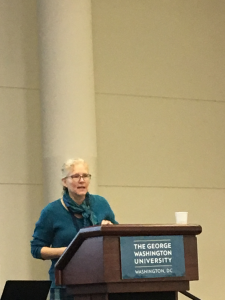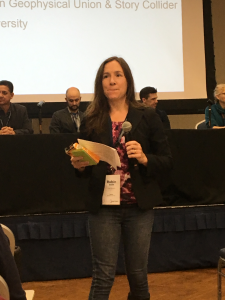By Özge Özkaya
How do you persuade a scientist to engage with the public? This was the topic of the "Oh now I get it" workshop of ScienceWriters 2018. The panel was made up of Robin Smith, science writer at Duke University; Shane Hanlon from AGU's sharing science program; Adam Connor-Simons, communications and media relations officer at Massachusetts Institute of Technology; and Mario Aguilera, the director of communications at UC San Diego. The session was organized by Alisa Machalek, senior science writer at the National Institutes of Health, and Laura Perry, director of communications at UCLA School of Nursing.
The session started with a game of "taboo" where participants were divided into two teams and members from each team were asked to explain a word that can have multiple meanings to the rest of the team. Words ranged from "cell" to "knock-out," and "assay" to "model." The exercise was emphasizing the importance of talking about complicated concepts without using scientific jargon.Robin then touched on the different reasons why scientists may not be willing to communicate their work with the public, including appearing too self-promotional, having no time, and not trusting the reporters and science writers to understand the true depth or meaning of their work.
The workshop continued with Shane taking the floor and talking about ways to overcome these obstacles in convincing scientists about the importance of communicating their work to the public.
"Tweeting only takes seconds," Shane said, so lack of time should not be a constraint as long as the right way of communicating is chosen.
He then touched on the reasons why scientists should even bother reaching out to the public and a wider non-scientist audience. "Most Americans cannot name a living scientist," Shane said, "so there is a moral obligation to do so."
He also mentioned that communicating their work to the general public can actually increase the chances of a scientist getting funding as well as increasing scientific citations. "Communicating their work to a wider audience can renew scientists' enthusiasm and increase their institutional recognition," Shane added.The session continued with Adam talking about the four Cs of good communication: concise, conversational, clever, and correct. To be concise scientists should "jot down two or three takeaways before an interview with a journalist," Adam said. They should "think about the answers to a few likely questions," he added, about the ethical implications of their work, for example. He moved on to being "conversational" or using plain spoken language without oversimplifying facts and avoiding wordiness. "Being clever," Adam said, "is about making the message interesting, intuitive, and relatable." He stressed the importance of being vivid and visual, of using metaphors and analogies whenever possible, and learning from others in the field who explain concepts in press when talking about similar things.
The session concluded with Mario talking about how scientists can be trained in using social media effectively to engage with non-scientists and the tools that are at their disposal. Mario also talked about the research communication program that is being developed at UC San Diego to help scientists better communicate with a wider audience.


